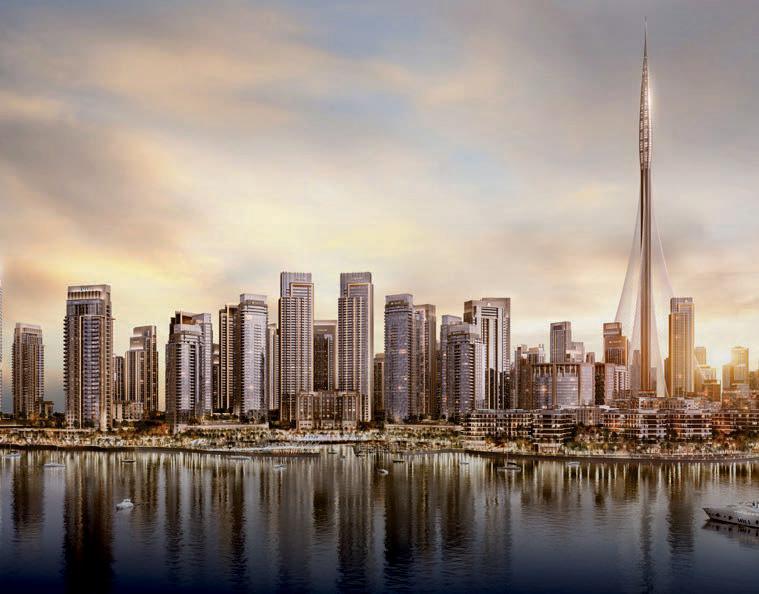GOING MODULAR Is it time to take stock and assess risks, or go big?
AN EVOLVING BRAND Casa Milano’s Azhar Sajan on the brand’s future directions
THE MARKET HKA’s Haroon Niazi speaks out about the GCC

GOING MODULAR Is it time to take stock and assess risks, or go big?
AN EVOLVING BRAND Casa Milano’s Azhar Sajan on the brand’s future directions
THE MARKET HKA’s Haroon Niazi speaks out about the GCC
Neetu Choudhary on the role of Neuroscience in diversity and inclusion


Middle East Consultant spoke to personal development coach and corporate trainer Neetu Choudhary about the neuroscience of why Diversity & Inclusion is so difficult…

Offsite manufacture and modular construction are increasing in importance - but the quest to build at speed can bring a raft of risks that are not well understood

Paul Godfrey spoke to Haroon Niazi, Partner, Head of Middle East, HKA, about the findings of the CRUX Insight Report - and how, in the light of its powerful analysis, he sees the future of construction and development in the GCC
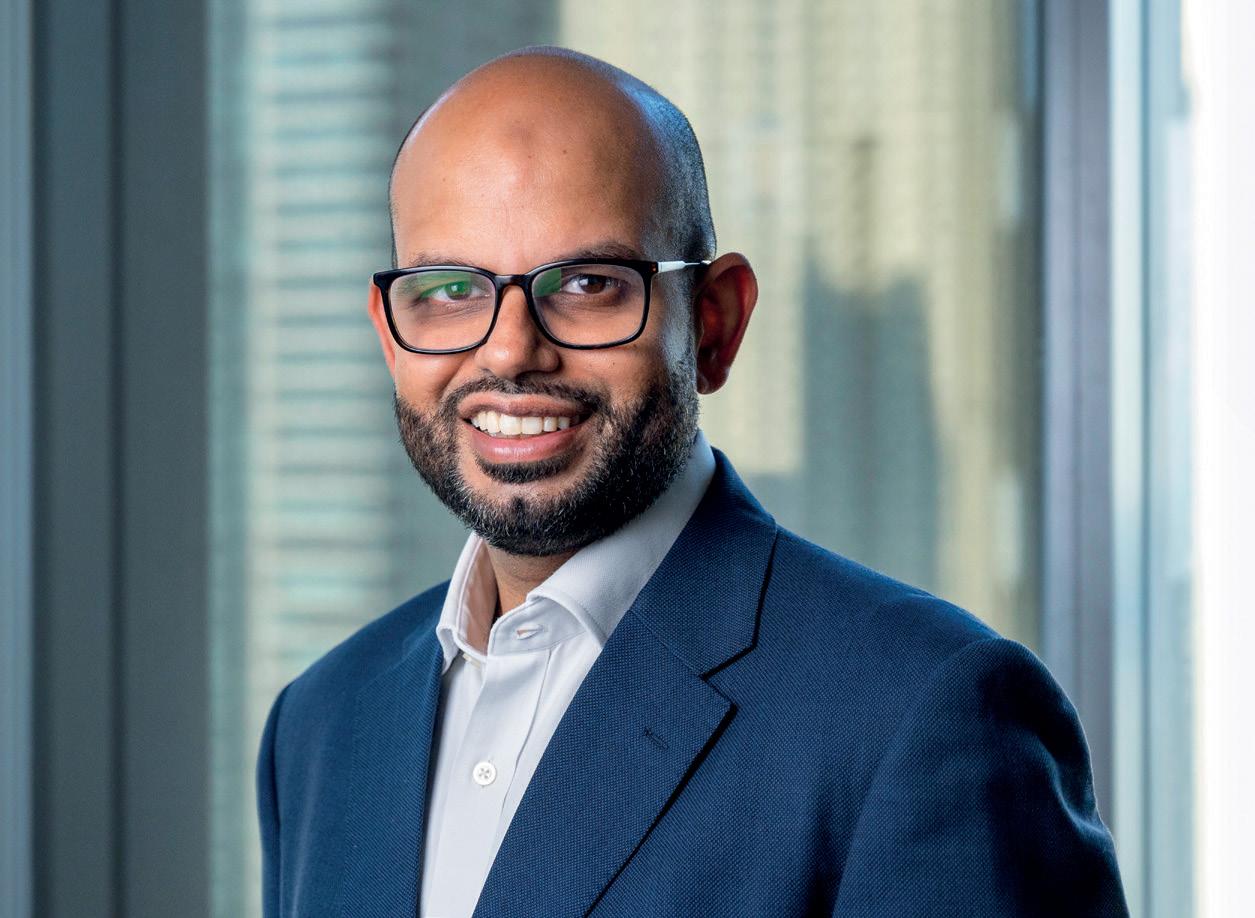

You want it but you don’t like it
Paul Godfrey examines the risk reduction protocols demanded by the new generation of super-highrise structures
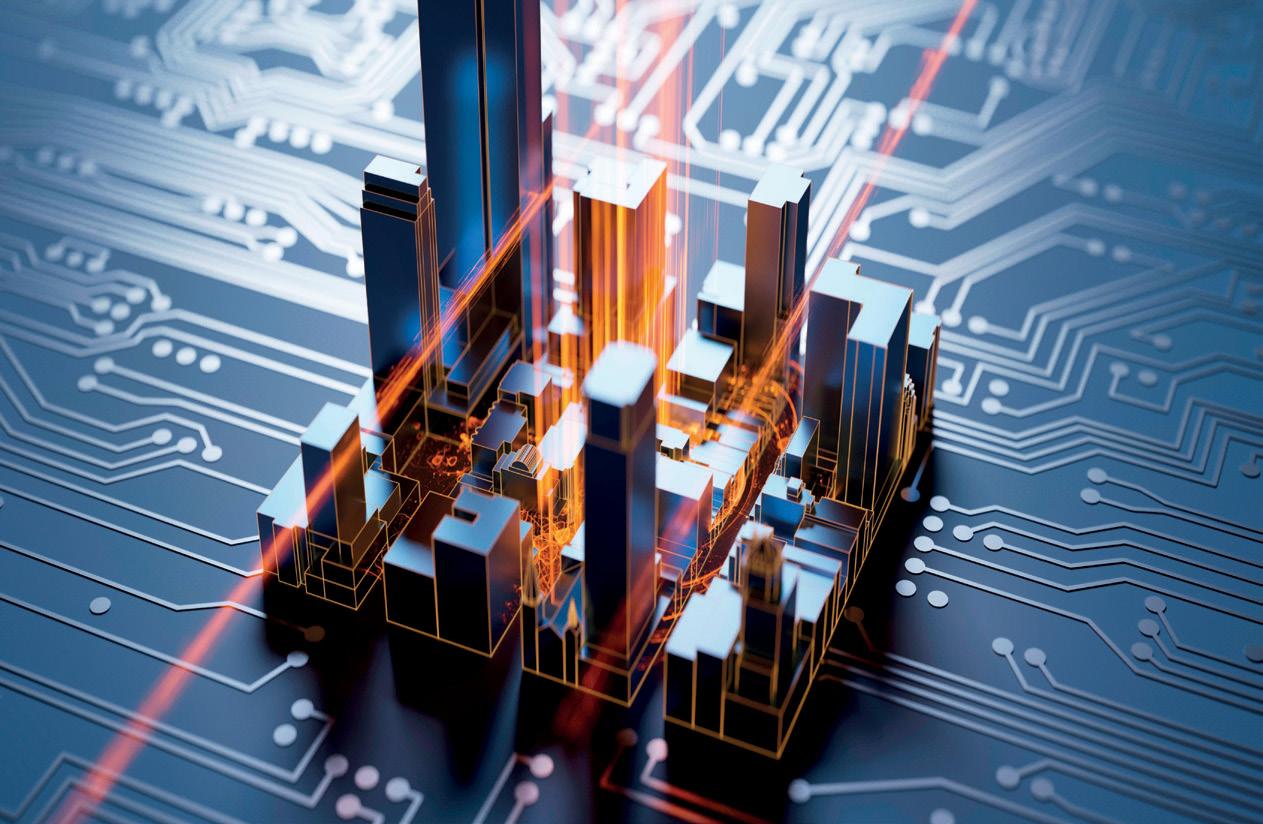
Middle East Consultant spoke to Mohammed Azhar Sajan, Director, Casa Milano, about the success and future directions of a brand that describes itself as ‘reflecting passion and perfection’


Middle East Consultant spoke to Carolina Fong Guzzy, Co-Founder/ Digital Engineering Manager, Accienta, about the processes, skills, and operational platforms that the Digital Transformation journey will involve
Comment “The Team are the people running everything”

I was recently reading an intriguing article about Sky City 1000 - the ill-fated and now largely-forgotten super-tall that was slated to be built in Tokyo back in the late 1980s. It was going to be 1,000m high with 196 floors - but like so many other proposals for a true ‘vertical city’ it was never built.
Super-talls, of course, fit in well where the land prices are astronomical - giving huge volume for a relatively small footprint - and on the face of things, Sky City 1000 would have been an ideal project given Japan’s crippling real estate values. So - why don’t we build super-tall more often? After all, the tech has existed for a very long time, but even in the early days of high-rises, which were full of euphoria, so many planned projects were never built. Perhaps the greatest example of all was the so-called Volkshalle (Hall of the People), destined to be built in the centre of Berlin in 1939, 300m high and seating 250,000 people in the largest dome ever conceived. But not a single piece of ground was ever broken.
Of course, there is Merdeka 118, Burj Khalifa and the Shanghai Tower, but super-tall remains far from normal, far from common.
Interestingly, in the current crop of Saudi giga-projects - as reported in our recent supplement Going Giga - what we tend to see is that, even when budgets are vast, there is a preference for following the new ‘15-minute city’ model. This is where everything you need to live and work is not more than 15-minutes away - the park, your home, your office, the gym, the children’s school and the Amazon warehouse that you’ll order everything from. This model is so beloved by the giga-projects that The Line, for example, puts 130 of them next to each other.
Meanwhile, we hear from the superrich apartment owners in Manhattan’s 432 Park Avenue that super-tall brings a litany of issues, such as endless problems with the supercharged elevators, water damage from plumbing, and walls that creek like the galley of a ship. Clearly, multi-million dollar price tags don’t guarantee problem-free living, right?
Yet one thing’s for sure: super-talls look so good, don’t they? They are the epitome of humanity’s ever-progressing ability to find ingenious, incredible solutions. Please, can we have some more of them in 2023?
MANAGING DIRECTOR RAZ ISLAM raz.islam@cpitrademedia.com +971 4 375 5471
MANAGING PARTNER VIJAYA CHERIAN vijaya.cherian@cpitrademedia.com +971 4 375 5713
DIRECTOR OF FINANCE & BUSINESS OPERATIONS
SHIYAS KAREEM shiyas.kareem@cpitrademedia.com +971 4 375 5474
PUBLISHING DIRECTOR ANDY PITOIS andy.pitois@cpitrademedia.com +971 4 375 5473
EDITOR PAUL GODFREY paul.godfrey@cpitrademedia.com +971 4 375 5470
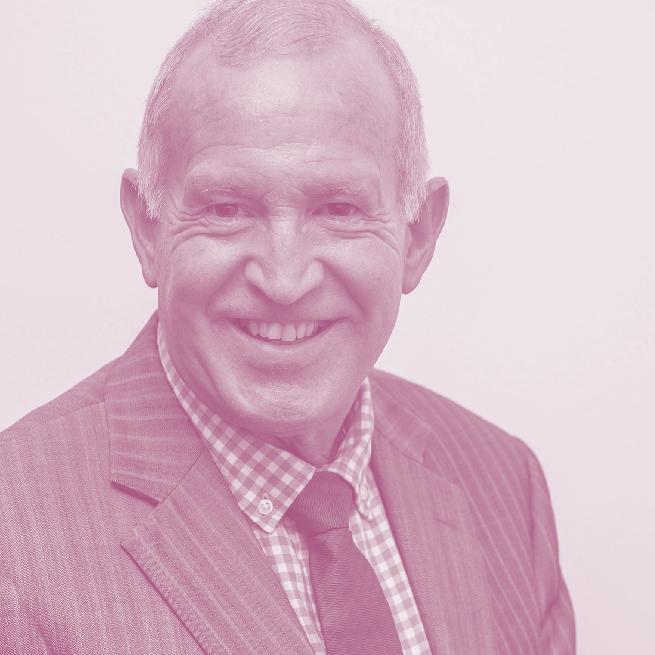

ART DIRECTOR SIMON COBON GRAPHIC DESIGNER PERCIVAL MANALAYSAY PHOTOGRAPHER MAKSYM PORIECHKIN
DATA & PRODUCTION MANAGER PHINSON MATHEW GEORGE phinson.george@cpitrademedia.com +971 4 375 5476
EVENTS EXECUTIVE MINARA SALAKHI minara.s@cpitrademedia.com +971 4 433 2856
SOCIAL MEDIA EXECUTIVE DARA RASHWAN dara.rashwan@cpitrademedia.com
ABDUL BAEIS UMAIR KHAN FOUNDER DOMINIC DE SOUSA (1959-2015) Published
CPI Trade Media. PO Box 13700, Dubai, UAE. +971 4 375 5470 cpitrademedia.com
Editor, Middle East ConsultantTITANE 65, The high endurance entrance door: Timeless, elegant and robust, offering enhanced resistance and durability.
Staying ahead means reinventing! When innovation and design are united in perfect harmony, it marks the beginning of a new way to inspire and imagine. A door with a minimalist design capable of adapting to and serving any architectural project. Designed with great attention to details, for private or public heavy use. Thermally insulated, available in multiple configurations, with large dimensions 1.4 m wide by up to 4 m high and 250 kg weight per leaf. Endurance tested over more than 1 million cycles. Reinforced with unique safety and security features.







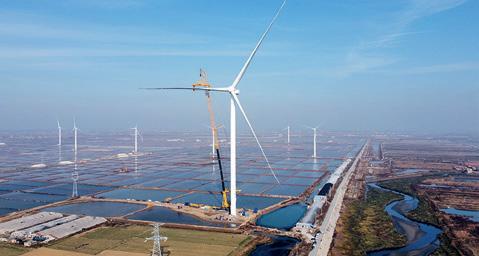


CONSTRUCTION GUtech 3D prints three structures in eight days in Oman The university said that the project used minimal labor and had a very low cost of concrete material
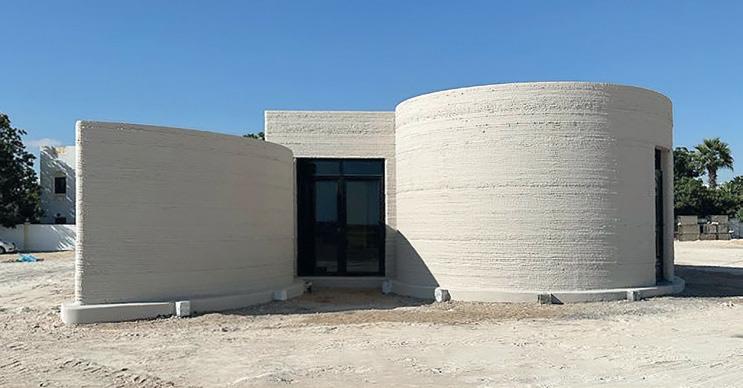
PROPERTY RAK Properties breaks ground at Bay Residences The 324-unit development is set to offer seafront living on sought-after Hayat Island



INFRASTRUCTURE Emicool to increase solar capacity by 238% The partnership with Emirates Electrical Engineering aims to increase solar capacity at one of its district cooling plants to 350KWP

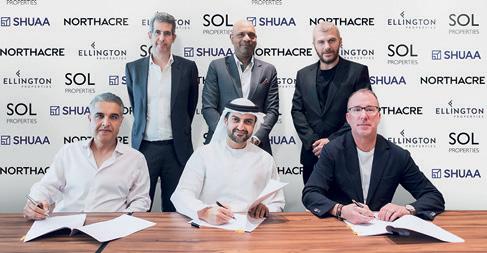

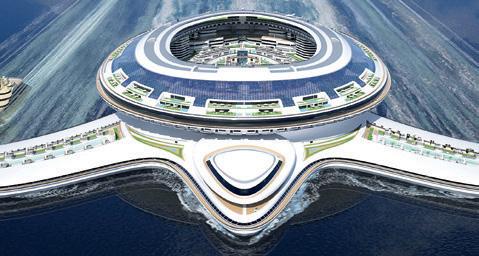
MACHINERY Manufacturers collaborate to offer universal battery solution for construction equipment The collaboration between Wacker Neuson, Bomag, Mikasa, Swepac and Enarco eliminates the need to manage different battery and charging systems

SUSTAINABILITY


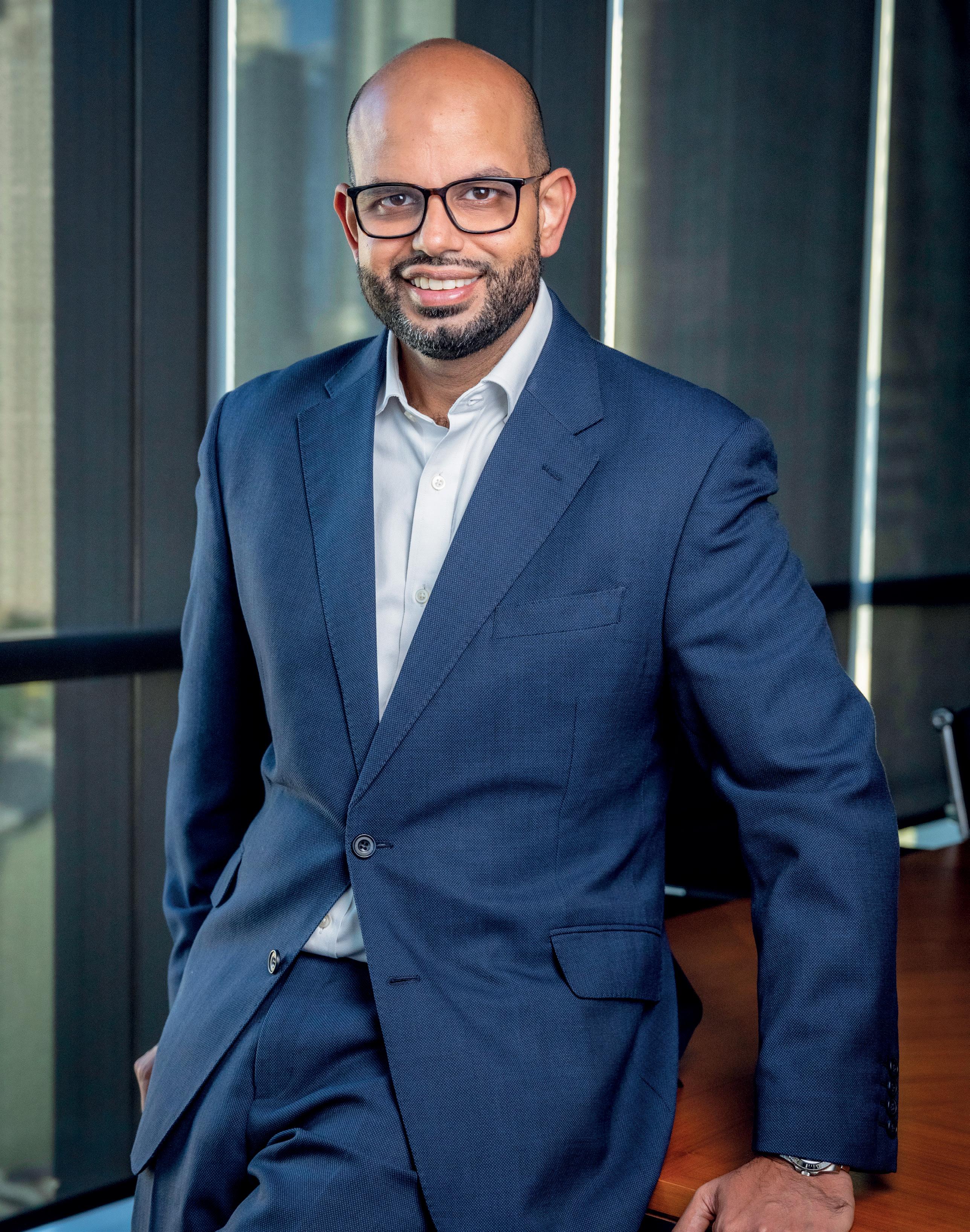
KA’s latest CRUX Insight Report investigates claims and disputes on 1,602 projects in 100 countries. Looking at developments with a combined CAPEX amounting to more than $2.13tn, the Report’s key findings include the following:
• On average, costs claimed in disputes amounted to $98.7 million per project and more than a third of their capital expenditure (35.1% of CAPEX).
• Projects faced even heavier losses in time. Claimed time extensions average 16.5 months - equivalent to 68.6% of the original planned project duration.
• Projects in the Middle East are prone to the worst delays (83.1% of schedule duration).
The analysis reveals that major capital projects are facing significant overruns in costs and delivery. Total claims analysed exceeded $80 billion in value, while the cumulative overruns total a staggering 840 years.
Haroon, in light of the above, do you see a deteriorating picture of Capital project trends?
“If we look at the overall picture, it shows that globally, there are headwinds facing the construction industry and also structural issues in some regions. However, we still see extremely strong construction spend that is relatively consistent and stable in the Middle East. For Governments in this part of the world, spending on construction and infrastructure is a key part of the region’s growth strategy.
“So, there’s no doubt that we need to tackle the many challenges and issues on major complex projects quickly to avoid cost overruns and prolonged delays The fact is, here in the region, we can’t insulate ourselves from the global picture. We are facing similar challenges that other countries are facing; interest
Paul Godfrey spoke to Haroon Niazi, Partner, Head of Middle East, HKA, about the findings of the CRUX Insight Report - and how, in the light of its powerful analysis, he sees the future of construction and development in the GCC
rates are going up over here because we are de facto linked to the US economy and the dollar. Yet it must be said that at the moment, the job market is quite resilient, particularly in our industry.
“If I were to look at some of the primary issues affecting that market, one of the main dynamics is the ‘War for Talent’ – skilled workers and suppliers. If we’re thinking in terms of sheer volume, the numbers and availability aren’t what they were, while those professionals with talent and experience can command large returns, as well as be susceptible to competitive offers once in situ.
“Meanwhile, the ‘Gig Economy’revolving around well-paid freelance working - has made its way to the region, slightly differently to the way it is operating in Europe, but it’s quietly growing under the radar. This will impact the kind of work that people choose to do. So, there are shifting market and employment conditions all the time, which, if we’re wise, we have to factor in and take account of.”
Why do you feel it is that projects in the Middle East are prone to the worst delays - 81.3% of project duration?
“Well, when we see delays, I think firstly we need to consider whether the initial programme or schedule was actually viable. Did everyone subscribe to it not because it was logical, achievable and fair, but because the project seemed highly appealing and worth taking a risk on? If so, what was that risk? From my perspective, I consider that the level of risk assessment around programming in the region still lacks maturity.
“For me, all this talks to the level of due diligence, change in scope (which is, by the way, the number one factor provoking significant delays) and how the project was brought to market. Is the right contractor involved, and does the contractor have sufficient capacity to deliver? If changes are expected from day one, then is there a credible change management strategy? If change is anticipated, then a key issue to be considered is the financing of change. We’ve all worked on projects where the contractor might undertake the variation on a project on day 20, but then won’t get paid for it until day 200! Who’s responsible? In my opinion, every stakeholder on the project is responsible. Remember, too, that this is just one example - imagine the consequences when a project is faced with numerous changes.
“Also, you must be realistic during feasibility and design development stage around change, and ask: Can you put the brakes on, when the deliverable date slips, the tender date slips, and so on? Now, the tendency is just to get on site and then resolve the issues ‘as we go’. I think contractors are excellent problemsolvers. But serious problems occur when all the stakeholders aren’t on the same page - for example, design issues and contract administration can easily lead to disputes. Then, there’s the indirect impact which talks to the ‘culture’ of the project, the collaboration on the project - and if these aren’t aligned, it can lead to all kinds of disputes.”
Are we going to see these same issues across KSA’s giga-projects, which are trying hard to set new benchmarks and world-class
standards and expectations?
“Yes, to an extent, we will see these issues also impact the giga-projects in Saudi. In fact, we are already seeing slippage due to several substantive issues. Despite the best of intentions, one of the questions we need to ask ourselves on projects of this scale is: Have we as an industry used data to make the right decisions? And how are we approaching each project to ensure that lessons learned from the past are fully considered?”
What can companies do to proactively overcome the challenges that the CRUX Insight Report demonstrates?

“Very simply, I would suggest revisiting risk management and the delivery strategy. Is it stress-tested around the causation factors set out in CRUX to ensure sufficient mitigation measures are in place to successfully overcome the challenges? If not, then it needs to be, otherwise, problems will continue to arise on the project.
“We also need to see more collaborative contracting - and here in the region, we arguably don’t see enough of this. For example, a design-and-build or a lumpsum contract are different, and each calls for a tailored approach to engagement with the market. In my view, the region is ready for the change to a more collaborative
approach. Given the supply and demand challenges, we will see contractors being selective in relation to which projects they do and do not want to work on. If an Employer is setting itself apart from others via its procurement strategy, then in an overheated market it could prove to be a decisive factor.”
What about PPP enterprises and their track record in the region?
“PPPs have been relatively successful in the region, especially in the Power sector. In the power industries, key stakeholders have carefully established how to deliver a financial model that works. A primary issue is, of course, the fact that demand remains strong. We are yet to see other sectors
When we see delays, I think firstly we need to consider whether the initial schedule was actually viable. Did everyone subscribe to it not because it was achievable and fair, but because the project seemed worth taking a risk on?”The CRUX Insight Report generates a wealth of comment on the plusses and minuses of construction in the GCC.
within the infrastructure space, such as roads and railways, successfully deliver to a PPP model. The infrastructure sector in particular has still a way to go. As we look at renewables and the diversification to renewables, we’ll see more opportunity for PPPs in the Power sector.”
What about contractual disputes, which are much-discussed here in the GCC?
“As for the all-important role of the contract, we need to ask why hardly anyone here is using EIC or collaborative contracting? But when I say collaborative contracting, I mean establishing a rigorous model that talks to KRAs, financial incentives and a balanced contract in

terms of the allocation of risk. What we are still witnessing is a trend towards the majority of risk being allocated to the contractor. This certainly remains an underlying cause for many disputes. Plus, we’ve all seen so many contracts with clusters of important amendments, but on occasion they are done on an ‘ad hoc’ basis and usually without a legal team involved. This simply isn’t a helpful way to proceed and certainly causes problems.
“There are other factors at play here too: for example, Value Engineering from the top-down seems to have almost disappeared - but we still see it being done on site, i.e. ‘We will resolve issues and make changes as we go along.’ This will be inevitably result in disputes.”
Typically, how will an intervention by HKA be structured, and what will it involve?
“Given the nature of our business, we’re suited to getting involved at any stage of a project. So, our work might entail setting up policies or procedures to ensure robust governance at the outset.

“Clearly, if we can be involved at that early stage - the sooner the better - the more effective we can be in ironing out issues before they trigger conflicts, and assisting with feasibility, programme management and delivery strategy.
“Often, though, we’ll be called in later, particularly when some of the project risks have materialized and a client requires assistance to either make, review or defend a claim. If things have turned sour and the parties are in dispute, then we will assist from an expert witness capacity as part of formal dispute proceedings.”
Why should the industry refer to CRUX?
“Of course, I’m bound to say that my dream would be for the CRUX report to be on the desk of every employer, contractor and engineer in the region.
If people use the report and its analysis proactively, we would see fewer projects with major cost overruns and long delays.
“A powerful step we can all take is to use the lessons and insights from the unique CRUX dataset to reduce delays, better inform what we are doing, and make decision-making more reliable. Realworld performance data is extremely powerful; unfortunately, it’s used much more often and effectively in industries other than our own.”
These awards celebrate the consultants - whether businesses or individuals - at the heart of the construction and development sectors. As well as honouring outstanding technical skills, they highlight the change-makers who deliver better, fairer, and more sustainable business.

The construction and development sectors are among the largest sources of income for every GCC nation and their innovation, scale and breadth of vision has helped focus world attention on the Middle East. These awards honour not only the subject specialists
– the architects, technicians, risk managers, designers, and technologists – but also the disruptors: the people pushing the envelope when it comes to critical factors like sustainability, gender balance and iconic leadership.
Ranging from the best multi-discipline consultant to the lighting firm of the year, the diversity of the categories aims to give a chance to all the companies that play a vital role in the industry.
Raise your brand profile, establish yourself as a thought leader and utilise this opportunity to encourage new business and empower your sales teams to generate effective new leads.
Paul Godfrey | +971 55 472 9717 paul.godfrey@cpitrademedia.com
Andy Pitois | +971 4 375 5473 andy.pitois@cpitrademedia.com
Architectural Company of the Year Cost Consulting Company of the Year Dispute Resolution Champion of the Year Gender & Ethical Employment Champion of the Year


Health & Safety And Wellness Champion of the Year
Interior Design Company of the Year Lighting Design Consultancy of the Year Mep Engineering Company of the Year Multi-Discipline Consulting Company of the Year
Project Management Company of the Year
Specialist Consulting Company of the Year Enterprise Business of the Year (Up to 5 Years Old)
Structural Engineering Company of the Year Sustainable Consultancy of the Year Company of the Year
Project of the Year – Government & Infrastructure
Sustainable Project of the Year – Retail & Public Facilities
Sustainable Project of the Year –Residential & Commercial Sustainable Project of the Year –Hospitality & Tourism
Under 30 Champion of the Year Executive of the Year Women in Construction Professional of the Year



survival value of this mental reflex, but our brains remain hard-wired to see someone new as a likely threat.
Want some practical proof? There are two interesting activities that I often include in workshops.
hile most leading organisations are proven to thrive on having a diverse workforce - and may well try hard to have a purposeful approach to diversity and inclusion - the human brain sees diversity as a threat. The human brain evolved for survival, not for diversity and inclusion. Survival is the most important thing for the brain, and it’s programmed to do anything to assure its owner survives. Survival instincts have been hardwired in our brains for thousands of generations. If this had not been the case, you might not be reading this article now, and I would not have written it. After all, we wouldn’t have been here if our ancestors had not survived.
Neuroscientists talk about the brain having Bias Patterns - and this is one of them. For human survival, the most important bias pattern is that ‘someone like me’ is harmless and someone ‘different from me’ is a threat. We Homo Sapiens have outgrown the prehistoric
The first one goes like this; I ask people to talk to anyone in the room for five minutes. 99 out of 100 times people choose someone like them; the choice is based on similar race, ethnicity, nationality, gender, age, looks, and even similar hair colour. It’s not surprising to me any more: don’t we love to twin up with someone who is like us, or as close as possible in appearance?
In another interesting exercise, I ask participants to write the names of their five closest friends. Then I ask them to write their age, gender, food habits, favourite restaurants, places they like to visit, movies they like to watch, games they follow, their preferred faith, etc. Guess what? Again, 99/100 times, people have friends with preferences very similar to theirs. All this happens outside their conscious brain.
The neuroscience of brain function reveals interesting ambiguities about inclusion.
We are biased, all of us are. No matter how profoundly we proclaim to be inclusive, tolerant, acceptable, and open to all, our subconscious brain is conditioned to categorise others so robotically that those who don’t look like us will register as a threat immediately. Plus, all this happens super-fast - in about 200 milliseconds.
I encourage you to do both of the above activities yourself, to see how your brain responds. Later, do both activities with your team. The results will surprise you; perceiving diversity as a threat is hardwired in our brains for our survival.
From the diversity and inclusion perspective, there are three main elements to our brain:
• Brain Stem - This manages the pure Survival state, regulating many bodily activities, including heart rhythm, breathing, blood flow, and oxygen and carbon dioxide levels.
• Limbic Brain – This manages the Emotional state - fight, flight or freeze responses
• Prefrontal lobes - These manage the Executive state - cognitive control functions, thinking logically, analysing When we feel unsafe in an unfamiliar encounter, the limbic brain takes over the control and it happens at a subconscious level.
All this, of course, begs the question of why do we subconsciously like to connect with someone like us?
1. It is safe, as it’s already known to you. Your brain has past data on it. Your brain can predict the other party’s response and their next moves far better than it can with someone who is entirely unknown.
2. The chances of your ideas being rejected are much lower.
3. You follow their language, expressions, and thoughts to some extent, which helps the brain utilise less resources to analyse and deliver the response.
Having said that, our brain is not necessarily a very modern tool: it’s a bit slow in evolving and still lingers on to the
Well-known coach and public speaker Neetu Choudhary has spent more than a decade researching and commenting on neural aspects of ED&I.

past data it utilised when our ancestors were living in the wild. We each bring those ancient neurological circuits to work every day. By the time we consciously analyse information and decide whom we should approach to ask for help, or whom we should select in an interview, our subconscious mind has absorbed that
information and sent it through to the fight, flight, or freeze networks. Anything new is a danger, and will trigger a response to assure your survival. It happens in a fraction of a second, even before we realise it (if we ever actually realise it consciously).
The brain is structured to characterise a newly-encountered person - very quickly - as a friend or foe. The brain does not distinguish between an approaching tiger and a person who looks, talks, and dresses entirely differently from your. Consciously, you may talk about diversity, but your subconscious brain does not like it.
We have hundreds of biases, and one related to diversity and inclusion is classified as “SEEDS of bias”: similarity, expedience, experience, distance, and safety.
1. Similarity: When anyone looks at someone, they don’t look for differences; they look for themselves; they look for commonalities; they look for similarities. We prefer the people we see to be similar to ourselves, and that’s to the detriment of those we perceive as different: it’s a true “us vs. them.” Our evolutionary history, survival instincts, and, most importantly, cognitive
and neural biases, make similarity and exclusion, instead of diversity and inclusion, our natural ways of operating.
2. Expedience: The brain consumes about 20 percent of the body’s energy and makes millions of decisions for us every millisecond. This implies that it must operate at peak efficiency. The best way to do that is for the brain to make quick and efficient decisions, freeing up processing resources to devote to other, potentially more pressing, matters. However, this comes at a cost; these decisions are based on past information and filling in the missing data, so they may sometimes be faulty or incorrect judgments. In situations where gathering relevant data is critical to making the best decisions, brain-based intuitive decisions are biased. Business-critical decisions, where cognitive diversity is required to gather holistic views and diverse opinions, are compromised by the brain’s ability to make intuitive decisions depending on what feels right, what information is most easily accessible, and what confirms initial assumptions.
3. Experience: We assume the way we see the world based on our experience is right, even when we do not have a holistic view of the situation. “I am always correct.” We see the world through the glasses we wear, which may be tinted and not show us the real view. These decisions are made at the subconscious level, which makes them more difficult to address. One classic bias of experience is the “bias blind spot,” where a person can quickly and easily identify biases in other people but believes that his or her own decisions and behaviours are bias-free.
4. Distance: We subconsciously place greater value on things that are close to us, relative to things that are perceived as being farther away. This includes both your property and that of others; something that is happening now as opposed to something that will happen tomorrow or in a year or so. The brain prefers instant gratification, instant results, and instant analysis of data. The brain is wired to give more weight to things that are more likely to affect us right now than things that will affect us in a year. Translate that to business meetings, and we
are more likely to accept the ideas of the person we see, know, or who is more vocal or has more authority.
5. Safety: The human brain is evolved for survival, and it constantly looks for the environment that is potentially negative or could pose a threat. This contributes to safety biases and the belief that bad is more powerful than good. Unknowns equal “potentially dangerous,” and a new idea is initially perceived as a threat until one consciously attempts to listen to it.
Now, diversity addresses these choices head-on, of course: it inherently includes “different,” “challenging,” and “novel.” In fact, diversity is good to break cognitive biases, but this is just one part of the story. Let’s not get ahead of ourselves, though, because there is another factor we need to consider first.
Knowing we are inherently biased is the first step to breaking these subconscious biases consciously. The brain is not only about survival - there’s also some good news too. Our brain is not our enemy: while it assures we survive, in other ways and at other levels it is also highly flexible, adaptive and evolving to new changes. This concept is called neuroplasticity. The brain is never the same, it keeps changing, keeps reorganising, and keeps reconfiguring itself with every experience we have every day. Neuroplasticity means the brain is like plastic, as has the plasticity to reorganise itself with new experiences.
There is another real test for the brain, which is a bigger challenge than diversity: it’s Inclusion.
Diversity is, at the end of the day, a ‘numbers game’ that involves having employees from diverse backgrounds. It can be achieved by methods like Positive Action, and so on. All of which is ostensibly is easy to achieve - KPIs can be set for it, targets can be defined, and it’s possible to measure our quotas easily.

But inclusion is different. The most difficult part about inclusion is that it’s not so much a numbers game, it’s more

a ‘culture game’. By this I mean that it requires bigger, deeper, and unshakeable commitment from top management, which needs to be cascaded down to the bottom.
Cultural change is the most difficult part, and it requires everyone to be involved.
First things first. Don’t try to change beliefs, though, as people will have innate stereotypes and trying to change them will just aggravate the problem. Instead, try to change behaviour by role-modelling it, by walking the talk and showing everyone - at every level - how to do it.
True inclusion takes longer than diversity; fixing numbers is much easier than changing behaviour when subconscious resistance exists.
So, what are the steps to progress? There are four steps to follow:
1. Self-awareness: Firstly, understand how the brain works and realise we are all hardwired to be biased. This realisation is required before you can break the bias up by making it conscious - and you’ll need to do that if you want diversity and inclusion to reach a significant level. Don’t blame people; blaming them for something they have not
Diversity in the workplace brings proven benefits but requires objective analysis and decision-making.

been consciously aware of would not help.
2. Recognize: Whenever you feel you are making a hasty decision, take a step back and acknowledge that you may be biased toward someone other than yourself. Give yourself time to rethink, take a second-person perspective, and analyse before deciding.
3. Be curious: Go on an adventure and try to explore what other opinions might be possible. The more you enjoy this exploration journey, the better you will utilise neuroplasticity to recode preprogrammed biases.
4. Appreciate: Express your appreciation for differences. The more you appreciate others, the more willing they will be to share their thoughts, suggestions, and ideas for your company. Everyone loves appreciation; it makes acceptance smooth and improves culture.
Be patient with yourself, your team, and everyone else on this journey toward diversity and inclusion. Remember that it will take time and effort to reconfigure a million years-old information set. Putting targets and KPIs on inclusion will make sense only when the organisation is mature enough to put numbers on intangible assets. Is yours?
We are biased, all of us are. No matter how profoundly we proclaim to be inclusive, tolerant, acceptable, and open to all, our subconscious brain is conditioned to categorise others so robotically that those who don’t look like us will register as a threat immediately”C M Y CM MY CY CMY K

ffsite manufacture and modular construction are part of what we now term ‘modern methods of construction’, or MMC. This is a key element of the changing Construction industry, alongside digital engineering and on-site technological advancements.

Offsite manufacture has been in resurgence for housing developments and large commercial builds across the world, with North America leading growth, followed closely by Asia Pacific. Its use in the GCC is also increasing. In surveys of delegates taken at conferences over the last year, it has scored consistently in the top three areas of change to affect the industry, alongside BIM and digital engineering.
Meanwhile, in the UK, for example, the practice has also been further boosted when then-prime minister Boris Johnson exhorted the construction sector to build back better, smarter and at speed to help the UK economy recover from the coronavirus pandemic. Globally, we’ve seen similar requests by leaders and governments in Malaysia, Brazil and China.
Offsite manufacture and modular construction are increasing in importance - but the quest to build at speed can bring a raft of risks that are not well understood.
Middle East
Consultant spoke to Andy Broome at the specialist insurance broker, Howden
The ability to replicate at speed can bring mixed results in terms of risk and liability.


In many nations, modular construction has historically seen barriers to uptake due to a tarnished image from 1960s pre-fab housing developments, with subpar manufacture and onsite integration issues. However, with recent technological advancements in both assembly line process control and digital design, many new start-ups are providing a one stop shop solution, from catalogued design through to integration on site. As a result, many traditional large D&B contractors have created in-house MMC divisions, with some moving the actual manufacturing of components or units to their own factories.
There are various degrees of off-site manufacture, from using components like walls, panelling, stairs, roofs, and sub structural frames, to whole housing units or modular fitted-out rooms being produced in a factory before delivery to site, all of which can be integrated with existing buildings. This means our homes and places of work can be produced in similar fashion to how the aerospace and motor vehicle industry have always done things. There are many benefits, but also many challenges to working in this way.
A key issue for the risk management and insurance sectors is whether, given that we have little data for modular construction at this stage, we can keep faith with the view that implementation of modular and off-site manufacturing is positive. At least, that is, until such time as we have long-tail claim data to judge. Currently there are points for and against.
The advantages of a factory-based process are controlled conditions, meaning that projects are not at the mercy of factors like extreme temperatures impacting assembly. Also, high quality control and consistency checks mean snagging is minimized, and costs of defects on insurance are reduced.
With fewer skilled people required on site, human error is also reduced in implementing designs to the build.
Factories also become safer, more
controlled environments compared to building sites, meaning we may see less claims under an employer and public liability policy. And, construction activities that would ordinarily have to be sequenced can now be performed simultaneously, again reducing the period of construction projects which ultimately reduces cost and insurable delays.
When it comes to material supply chain risk for offsite pre-construction, it would be the same as (or less than) conventional construction and indeed, modular companies could in fact have better supply access and stocking capacity than site-specific construction.

However, there are some potential risk issues that need to be considered from offsite manufacture. In some cases, modular builds have enabled fires to spread more quickly, especially as many units tend to be timber framed. For example, fire can spread through oxygen locked into the lightweight modular ‘building block’ materials, or cement exteriors falling from wall panels exposing flammable polystyrene interiors.
Also, given that modular buildings are often designed to look like they’re made from traditional materials, assessing risk by sight is not as easy for surveyors or tradespeople. This is also an issue for firefighters unfamiliar with the structures or materials.
In addition, having one firm capable of the manufacture of the units, rather than a series of smaller contractors assembling the entire building onsite, can create more vulnerability due to the narrow supply chains. If one company goes under in the supply chain, it can cause issues for practical completion costs and delays.
Also, unless the IP is licenced to the developers from a modular manufacturer and full designs of components are held within build documents, it’s easy to foresee issues of future misunderstandings of a building’s make up.
Some other risks to bear in mind include the following:
• Increased use of cranes may be needed on site for relatively small projects, affecting denial of access to surrounding properties, which is insured on many types of building policies.

• Transporting whole units is a complex endeavour, with the risk of completed modules themselves being damaged or destroyed in transit causing major construction delays. Also, road traffic incidents are a concern and careful thought around site access is needed.
• There is some evidence that a number of materials used in offsite construction are more susceptible to water damage.
• It is easy to foresee more manufacture of whole component units abroad, potentially from less regulated territories
Transporting whole units is a complex endeavour, with the risk of completed modules themselves being damaged or destroyed in transit causing major construction delays”C M Y CM MY CY CMY K
Our expert engineers design customised solutions that transforms natural sand and crushed rock reserves into high value products for an exceptional return on investment. An integrated water management system recycles up to 90% of process water for immediate re-use in the system, significantly reducing footprint and maintenance of settling ponds

ENGINEERED FOR YOU. Visit cdeglobal.com

meaning lower risk management in design and manufacture, and this could introduce marine transit and jurisdictional risks.
• Surveyors should be given access to the assembly line; otherwise gaps in their reports at PC can create losses to all parties Insurances.
A core problem with offsite modular construction is the potential for a design or manufacturing error to repeat itself in all components on a single project, or multiple projects, which is not always insurable for PII underwriters. Also, PII policies are written with products exclusions, excluding product sales, product recall, or product warranty. Whether a module or prefabricated unit is an actual ‘product’ is yet to be fully tested in law. It is advised that
the products exclusion under a PII policy is looked at, and a project-specific policy may be better to make sure nothing falls through the gaps between PII and other policies.
As the field is untested, contractors’ insurance, including liability insurance premiums for sites using offsite techniques, could be more expensive with higher excesses and more exclusions. We are seeing some insurers charging higher premiums on completed modular buildings and demanding more onerous surveys and higher levels of risk management if manufacture is ‘outsourced’.
Despite this, some insurers are starting to take on board the positive points made earlier around assembly line quality control which is a positive development. However, some questions that underwriters may still ask include:
Modular construction requires close consideration that we are not projecting innate flaws across macro-projects.

• Is the business performing their own additional quality assurance on supplied modules or prefabricated units?
• Do they require their manufacturers to maintain PII coverage?
• Geography becomes a consideration as well - are transport-to-site times short, and transit conditions easily monitored?
In the future we may see new insurance products being developed to follow the journey of offsite manufacture and wider MMC. It will be interesting to see how the claim rates pan out in the medium and longer term if the industry does adopt these new forms of build fully. At the end of the day, the question of the impact on risk may only be fully answered in time.


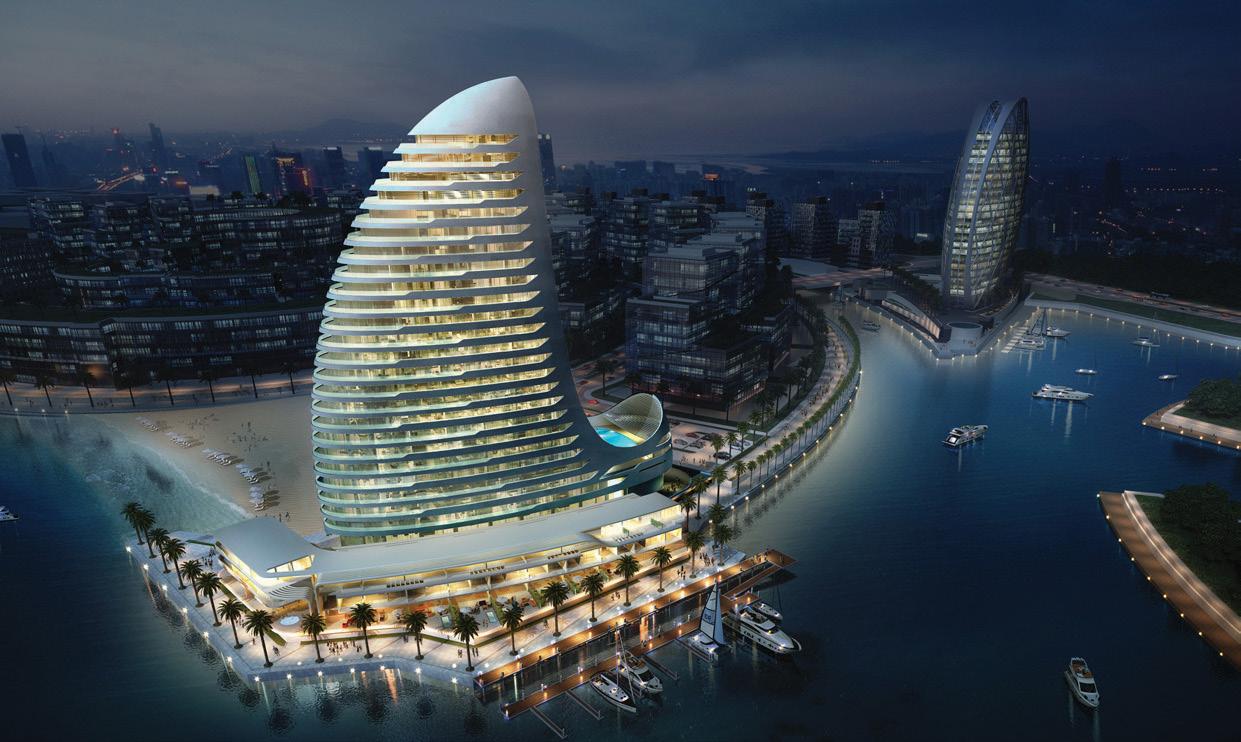

asa Milano prides itself on offering what it calls ‘Bathroom Expressions’. So there’s probably no better way for the firm to be celebrating its third birthday than by announcing a new partnership in the UAE with global sanitaryware brand Ideal Standard - a widelyrecognised international marque that is now complementing its decadeslong pedigree with a new portfolio of designer-led bathroom concepts.
Azhar Sajan is on record as saying: “Our 3rd year celebration couldn’t have gotten any better. We are elated to have associated with yet another global sanitaryware leader, Ideal Standard.”
So, Azhar, we hear that Casa Milano is committed to taking the bathroom living standard ‘to the next level’. How does the new partnership with Ideal Standard complement and help Casa Milano’s strategic growth?
“Well, the first thing I should say is that whereas we are of course still a very young company - with a three-year history - Ideal Standard is a global brand that’s very well-established over multiple decades. I want my customers to enjoy the trust and reputation that this brand brings. After all, we hear so much from the public about this name and its role in defining the market. It’s extremely well-recognised. Even in my own family, as a child, we used to have Ideal Standard bathware - and in fact, I can still remember the way that they wrote their signature on their products! It’s such a long-established brand, but it’s also very refreshing to see it now. It’s positioned as an upper-mid brand and it’s
a brand for everyone. Yet we’re also seeing an interesting evolution: the company has now released a number of new signature collections, which position them in a somewhat higher market segment. So now you have the advantage of a trusted brand that can also play a part in your new-look designer bathroom.
“For me, it’s one of the strongest brands I can offer my customers, but of course, we are a wide-ranging supplier and we can complement whatever look and feel you are aiming to create. We have a very big range in terms of sanitaryware and price positioning.”
Now you have expanded your offer, and will even advise on exterior landscaping, for example, will you typically do all the fit-out and installation work for clients, too?
“It’s important to remember that we are still a supplier at the end of the day; I’m assuming that the client will have researched who best to work with for their installation. If they want me to, I can recommend people to do the installation, but I firmly believe that the customer should go with who they feel most comfortable with.
“That process is very important, because clients who shop here will of course place a high importance on aspects like design, ISO certification, and so on, and it’s vital that the company responsible for the installation should use staff who are properly trained - that they can provide a service aligned with the quality of our products and the client’s own high expectations.”
Casa Milano started off as a sanitaryware specialist and has
Middle East Consultant spoke with Mohammed Azhar Sajan, Director, Casa Milano, about the success and future directions of a brand that describes itself as ‘reflecting passion and perfection’

now grown across a variety of other niches. How do you see your future?
“In a word, it’s all about expansion. I always had the vision that we should go for a broader market niche; now we can give customers a complete ‘one-stop shop’ solution. But whatever we do, it will - first and foremost - always be an extension of the theme that we first embraced with our sanitaryware: it will need to reflect our twin values of passion and perfection.”
Tell us more about how you liaise with corporate clients? Do you simplify their fit-out needs and can you provide fully customised solutions?
“Now, that’s an interesting question, but we think of it in terms of the generics, not who the customer is, or whether they are a private individual or a large developer: we are driven by the customer’s requirement. It depends purely on the type of product required and the quantity that’s involved.
“With developers, contractors and interior designers, I’m delighted that we can play a major role in what have proven to be some of the most iconic projects in the country. I see us as moving forward with the UAE - this country has fantastic vision and we’re proud to be part of that.”
Have people’s tastes changed postCovid? Has the pandemic altered the way people want to use and enjoy the space around them?
“Definitely. People wanted to change after Covid; they wanted to shift things around - they got bored with the way things were.
The workplace was also your home, you were spending more and more of the day there, and people got fed up with the same surroundings all the time. Remember: change can give you a new vibe, a good feeling, and you can say ‘it’s a refreshing taste’.
“Plus, people came to realise that some surfaces were easier to clean than others, and we place a high premium on giving them what they want: designs that are not only pleasing to look at, but can of course offer optimum convenience too.”
How do you now see your market position: would you be termed as a high-end provider, or do you work more generally across demographics?
“As I mentioned earlier, I see the future as all about expansion. The demographics of our customer-base have noticeably changed and broadened out. In the early days, the core of our customers were Emiratis; but as developments have grown up all around the country, and the number of units has increased dramatically, our customer-base has widened tremendously. We meet the needs of the home-buyers and apartment-seekers in diverse communities, and we want to be able to offer the combination of style, quality and taste that they prefer.”

Is Casa Milano strictly UAE-based or can you operate and supply across the GCC region?
“We are operating across the GCC. In terms of our key markets and how we prioritise our growth, I will take it step by step. I see some fantastic developments in Saudi Arabia, for example, and I would love to be involved with many of these. The vision is there, now we have to bring it to reality.”
What is your corporate Mission Statement and how is it best reflected in the service you provide and the corporate goals you have?
“I don’t really think so much in terms of a ‘Mission Statement’; I think much more about a ‘Culture Statement’ and what the business is like as a place to work in, and the way it interacts with its customers. So, for example, although you are speaking to me, the Team - whether on the shop floor or in the back officeare the people running everything at the end of the day; they are the ones in front the customers, managing the stock and creating the delivery chain that drives everything forward. We have created a culture whereby we’re very much a family business, and we think of everyone as a part of an extended family. In that family, everyone is empowered to talk ‘on behalf of me’. At the end of the day, I really only ask one thing: I urge them to speak to the customer with passion and knowledge.”
In a word, it’s all about expansion. I always had the vision that we should go for a broader market niche; now we can give customers a complete ‘one-stop shop’ solution”
"Teamwork", says Azhar, "is critical to the Casa Milano success story". C M Y CM MY CY CMY K
Office Location: Millennium Plaza Tower 14th Floor, Sheik Sayed Road P.O.Box 26290, Dubai, UAE www.intertek.com

non-technical skills that enable someone to interact effectively and harmoniously with others, are vital to organisations and can impact culture, mindsets, leadership, attitudes, and behaviours. Some examples are:
• Advanced communication and negotiation skills
• Interpersonal skills and empathy
• Leadership and management skills
• Entrepreneurship and initiative-taking
• Adaptability and continuous learning skills
• Teaching and training skills
digital transformation is a journey, but it’s also - sorry to say! - a disruption to day-to-day operations. It requires the entire team of internal and external stakeholders to think out-of-the-box and find the best fit, solution and combination of people, processes and platforms that can align to the agreed, specific set of goals.
The construction industry is evolving, and its transformation pace has increased in the last couple of years. Nevertheless, it’s estimated that 62% of construction professionals transfer field data manually or via spreadsheets and 30% of data created during design and
construction is lost by project closeout. This lack of information and reliability caused by poor project data and communication globally costs the industry 52% of the $280 billion annual rework costs. Consequently, there are clear concerns to be addressed that directly impact a company and project’s bottom line.
Capturing, retaining, and upskilling talent in an organisation has become an increasingly expensive challenge in recent years. In reality, this is an unprecedented time for the industry because skilled resources are scarce: many people claim to have knowledge of the current technologies and how to apply them, but this is not always true. Therefore, HR departments, managers and recruitment agencies need to focus on constantly assessing key skills. Also, strategic initiatives for upskilling teams are very important. All of which brings us on to the thorny topic of ‘hard skills v. soft skills’.
According to McKinsey & Company, Soft Skills are commonly defined as
On the other hand, Hard Skills pertain to a specific set of knowledge and to definable, quantifiable abilities. These can be acquired via training, courses, peer collaboration, mentorship, hands-on practice, etc.
Reskilling at scale is a concern and a priority for 80 percent of C-suite executives worldwide, according to a 2019 McKinsey survey. Reskilling significant portions of the workforce within the next 5-10 years will be required. As automation and artificial intelligence dramatically change the nature of work, employees must finetune the social and emotional abilities machines can’t - at least not yet - master. To encourage this behaviour, employers must adjust the ways they assess, educate, train and reward their workforce on soft skills such as collaboration, communication and critical thinking.

It is a combination of both soft skills and hard skills that are needed for a successful digital transformation journey. Hence, creating strategies and initiatives to further develop them are crucial for an organisation.
Organizational culture is as important as skills when traversing a digital transformation.
In a ‘Top-Down Structure’, the ‘Boss’/ Management asks for something, and all the levels of the organisation need to comply, no questions asked. This drives less
commitment and engagement from the team members who will often feel disenfranchised and undervalued as a result.
On the other hand, in a collaborative environment or ‘flat’ organizational structure all team members are equally heard and suggestions for improvement are implemented at all operational levels. This generates positive reinforcement and more engagement.
For a digital transformation journey to be successful, structures need to be flexible enough to promote the required collaboration, breaking departmental silos and Top-Down structures.

Moving over to the all-important ‘process’ component in a digital transformation journey, it’s important - first of all - to capture the current state of key workflows. By mapping steps, companies/roles, and information the team can re-evaluate and generate ideas on what can be improved with the use of technology.
Part of project cost is directly impacted by the team on and off site. Therefore, finding strategic ways to optimise and focus their time is a critical step in reducing waste and staying competitive in today’s market.
It is estimated that construction workers, at all levels, average over 14 hours lost per person, each week. That’s almost four hours a week dealing with mistakes and rework. Almost five hours a week is spent on conflict resolutions and 5.5 hours a week is spent simply looking for project data and information.
By introducing a cloud collaboration platform, companies can reduce this time and guarantee that decisions are made based on accurate, reliable, and live data.
Another angle for analysing and prioritising workflows is to observe process bottle necks or pain points - because these are usually where quick gains can be achieved.
Design, construction, and operations teams often struggle to find a seamless way to identify issues and circulate to appropriate
stakeholders. Therefore, a diverse set of platforms has been developed to cover different aspects of the industry for databacked decision making.
The industry’s overall objective is to utilise one single source of truth for project information and collaboration. Now, this is easier said than done, not because of technology but because each stakeholder prefers a certain vendor due to policies, pricing or other factors that affect the decision. As a result, consultants and contractors end up adopting the best solutions for their internal operations and the client/owner mandates another set of tools for communication and deliverables.
There is a rich mix of tools, vendors, and offerings in the market, but my advice is to always be mindful of overselling practices and work with a technology expert (like my own company, Accienta), who can tell you if the solution you are considering is appropriate for the use-case.
Document Management Systems & Correspondence: One of the earliest interactions between projects and platforms was via Document Management systems. It was a natural transition since teams were already producing documentation and this needed to be uploaded to an EDMS (Electronic Document Management System) for storing purposes. Also, more sophisticated capabilities like workflows and email correspondence were included as well.
Nowadays, while it’s still a useful capability to have, companies need to think how to go beyond a Document Management system because it lacks flexibility for collaboration and live decision-making. Common Data Environment: A CDE or Common Data Environment is defined as the single source of information used to collect, manage and disseminate documentation, the graphical model as well as non-graphical data, for the whole project team.
Many project owners like this concept but when it comes to its implementation, there are contractual low-trust interactions with the other stakeholders that may impede its full collaboration capabilities. Or the result will be a very structured and fixed environment which will comply with ISO19650 or required regulations but not have the key data flow as its guide.
In a high trust environment, all data can be transferred via the cloud, data is always live and can be accessed according to permission rights. Again, this is possible in terms of technology, but it requires the right agreements in place to successfully use one platform for the entire project and key stakeholders. When it comes to collaborating on only one platform there’s

This is an unprecedented time for the industry because skilled resources are scarce: many people claim to have knowledge of the current technologies and how to apply them, but this is not always true”
also a training/upskilling component that needs to be addressed by either the project owner or supply chain.
Cost Management - ERP and beyond: ERP systems have long been introduced to construction and it’s usually the first step that companies take to interact with a system. Because an ERP captures cost, it is great to track past costs based on cost codes. But it lacks project management applications, and that’s why, once companies move past implementing an ERP system, they’ll realise there’s still a need to complement operations with additional systems.
Project Management: The Project plan, team collaboration and ability to adapt to project changes is very important. It also directly impacts the project’s bottom line. Whether your organisation follows Waterfall, Agile, Scrum, Critical Path Method (CPM) or other methodology, you can use technological platforms to centralise information, capture key data and update other people involved or impacted by any project changes.
There are existing tools in the market which can now integrate to commonly used platforms like Primavera P6, Microsoft Project and others.
In these ever-changing times that the industry faces, an overall solution that increases the organisation’s ability to adapt to change is even more relevant.
Like Einstein used to say, “insanity is
Carolina Fong Guzzy believes that true digital transformation resides in a comprehensive understanding of exactly how the business works and what it wants to achieve.

doing the same thing over and over again and expecting different results.”
Task Management / Field Management: Task management and Field Management solutions can be part of the main operations platform for design and construction teams to quickly resolve issues on site or office. The tasks at hand can be assigned to a specific company, role or user in the system with a due date. Additionally, key metadata and custom attributes can be configured for each issue type in the system. For a more comprehensive perspective, there are tools in the market like Autodesk Build that can associate additional references like photos, videos, forms, assets, project schedule, in one single environment. This is a solution that touches upon all the previously mentioned platform categories and more.
Asset Management: Certain projects need specialised capabilities to track key assets (equipment, machines, expensive or fragile items, etc). Also, they may need to associate an asset status: for example: ordered, delivered, inspected, etc. which are fully customisable and colour-coded. Moreover, things really start to get
interesting when we can link assets with a 3D model because this brings us one step closer to achieving a true Digital Twin.
Tendering - Bidding platform: From the early stages of a project, when an owner is undergoing a tendering process to select key project stakeholders, a system can also help.
Creating a complete Digital Dashboard for all stakeholders to interact, update and submit requirements can facilitate communication and repetitive tasks. This provides the client entity visibility into the project bidders, project changes and reporting.
Client Communications: A project may also need an Integrated Digital Platform for client liaison. Communication plays a big role in a project’s success. The faster ability the client, contractor(s) and consultant(s) have to adapt to change, the less it will disrupt the project progress and generate minimum impact to time, quality and cost.
Portfolio View - Reporting: Capturing and reporting on key project metrics per country, office and project is crucial for owners, developers, consultants, and contractors with multiple, ongoing projects. This data can be captured at the project level and use data integrations with Smartsheet or Power BI as an example to further classify and customise dashboards.
A Digital Transformation strategy is a plan of action describing how a business must strategically reposition itself in the digital economy.
I hope the above is helpful in identifying the key components and giving you a sharp picture of the processes, skills, and operational platforms that the Digital Transformation journey will involve. As you can see, this journey has at its root the intention to revolutionise and revitalise the speed, accuracy and replicability with which your business works - and as such, it's a thoroughly worthwhile commitment to make.



Paul Godfrey examines the risk reduction protocols demanded by the new generation of super-high-rise structures



all buildings are becoming taller. Already, the average height of the 20 tallest buildings in the world is 600m - and that’s twice as high as the Eiffel Tower. What’s more, the so-called ‘super-talls’ (ie, above 350m) are being built faster than ever before, largely because of an insatiable market in Asia and the Middle East, where in recent years, a commitment to premium developments has been a core part of government strategy and national identity. The number of supertall buildings (101) in the world has almost tripled in the last seven years. Just 15 were built between 1930 and 1995.

How high can we actually build? Realistically, with current technology, we can build up to one mile (1.6 km) high. Why isn’t this happening yet? This sounds an exciting prospect, so what are the challenges?
Limiting factors include the efficiency and speed of elevators, new composite building materials to replace steel and concrete, safety controls and the use of advanced damping systems to counteract the effect of earthquake and high winds. The quest to factor in and deliver these approaches in the meantime creates a litany of risks in even the more modestly-sized super-talls. Meaning, of course, that proper risk management tools and sophisticated insurance packages are increasingly important for any developer or architect considering taking on a super-tall project - regardless of the prominence or prestige of the potential client.
Make no mistake here: the risks include:
• Not just the immediate impact of any seismic activity, but concomitant risks such as flooding during the construction stage
• Threats from high winds and fire
• Appropriate choices of building materials reflecting the need for lightweight construction and fireproofing (especially important with exterior cladding)
• The staggering complexity of managing projects that can involve as many as 10,000 workers and more than 100 subcontractors.
Then the raft of technical issues include:
• Pumping and placing concrete at extreme heights
• Cranage and lifting items at extreme heights
• ‘Warp’ effect of significant variation in wind speeds between ground level and higher levels, which affects design and construction works
• Maintaining true verticality as the building height increases
• Maintenance and repairs of inside and external elements
• Building services such as electrical, water and sewers
No wonder, then, that the insured values involved with super-tall buildings are increasing, with insurance playing a vital role in enabling such projects to advance past the design stage. (Note: today’s newest and largest buildings easily exceed $1 billion or more in value).
From the perspective of the insurer, each project must be planned and assessed on its own merits and specific risks. Timelines may extend, design plans may alter and engineering challenges may arise. Regular sharing of accurate management information to all stakeholders is crucial. Plus, of course, close evaluation of past claims is essential in preventing future claims. It goes without saying that appropriate insurance coverage is a key part of any holistic risk management strategy - but let’s not forget that as well as providing all risks building
and construction protection, insurers also provide after construction coverage, protecting policyholders against physical structural damages arising from defects in design, materials or workmanship. This is already being shown to be a key factor where Modular Construction techniques are used, which run the risk of churning out a slightly-flawed piece of assembly 1,000 times over. A vital component can include within it hidden flaws that may not be detected until after several months in use.
For an insurer or reinsurer engaged with super-tall projects, a good starting-point is to assess what level of risk - and impactany seismic or natural catastrophe activity might have on the structure.

Proper risk management of super-talls begins with exceptionally deep foundations with complex stress resistance.
“If an event such as an earthquake or another natural hazard was to occur, it could obviously have a potential impact,” says Clive Trencher, senior risk consultant at AGCS. “Therefore, the foundations need to be adequately designed and constructed to withstand such an event. Consideration also has to be given to potential exposures such as flash flooding, which may pose a risk when initial building work starts on such projects because there will be large excavations in the ground.”
The choice of building materials also poses challenges. Glass panels need to be
thicker and more durable for the higher stories, while concrete mixes designs also have to vary so they can withstand the differing buildings loads that vary with height.
Fire risk in tall buildings, both during the construction and occupied phases, is a multiplied risk factor and represents a considerable challenge for designers and engineers. Evacuation of a building that has multiple purposes like hotels, restaurants, residential areas, shopping centers and offices is crucial, especially considering the number of people to be evacuated within a short time period. Thus an enormous focus lies on the design of sprinkler systems, escape rooms and fire resistant structures at an early stage of design.
Although many of the technical issues that the latest high-rise building projects face may appear similar to previous super-tall and mega-tall developments, it’s always advisable not to make assumptions that the same technical solutions can be used.
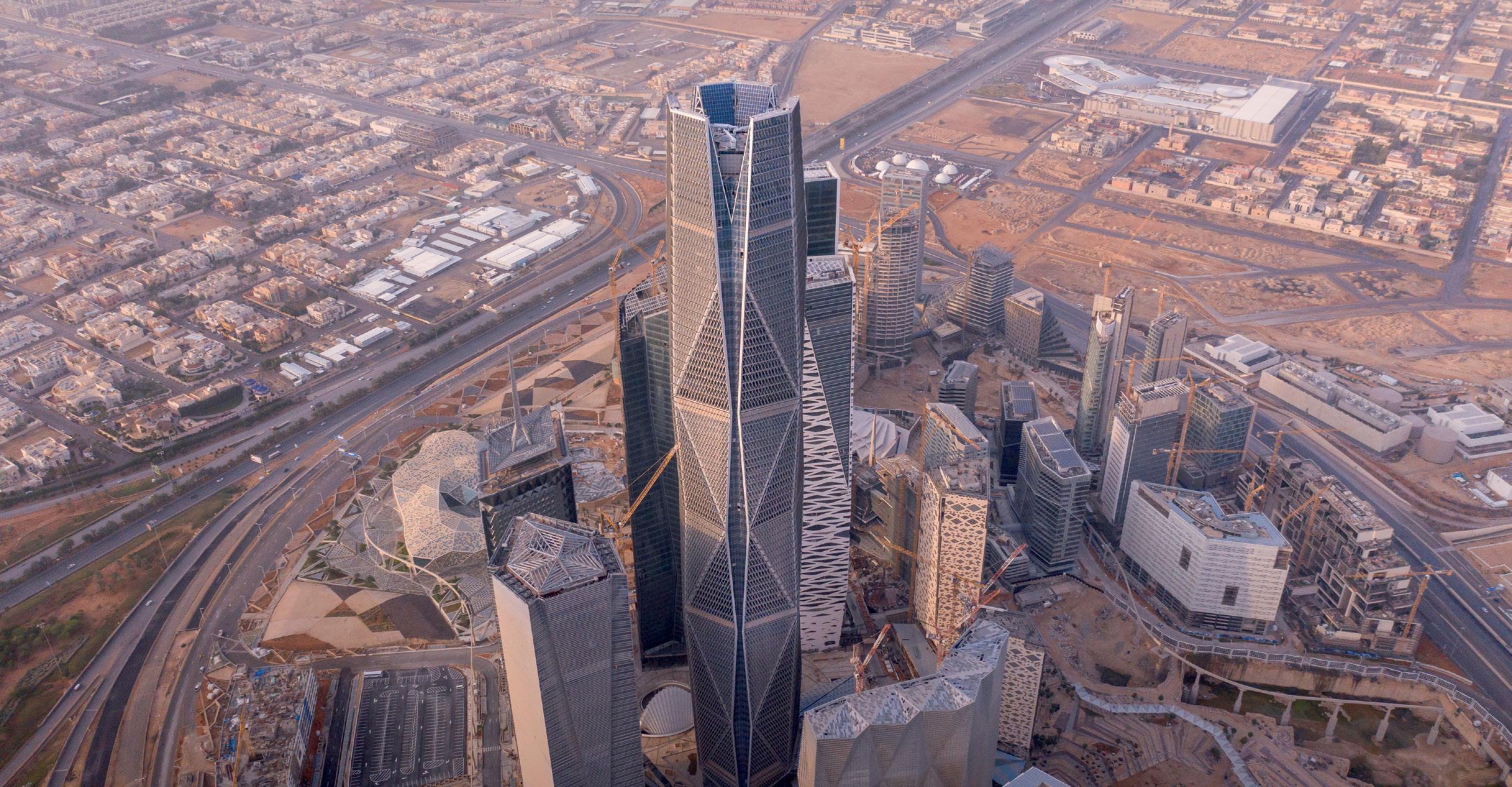
The structure’s cross-section must be wind compliant, hence we see more and more semi-circular designs.
“Such constructions are unique projects facing unique risks. Every construction project faces challenges and the more ambitious and large-scale the project might be, the more challenges it will create,” says Clive Trencher. “Each project has to be planned and assessed on its own merits and specific risks. While we may learn some techniques from the construction of other tall buildings, it would be wrong to assume that they can be fully risk assessed or planned just because they have been used on similar tall structures.”
Super-tall building projects bring unique complexity. Such construction projects are time-consuming. Joint ventures, clients, consultants, subcontractors and suppliers need to work closely and act as a team. In fact, organising and managing subcontractors and suppliers requires a dedicated and highly experienced
team, and strong management becomes vital for the success of projects of this scale. Similarly, regular and accurate management information on the building’s progress and any emerging risks is crucial. What’s more, the risks don’t stop when the construction is completed. The unexpected consequences of building so high with ‘new’ materials (for which we have little case history) may well highlight the need for ongoing risk mitigation strategies. While it might arguably be true that most stakeholders would see these a ‘given’ during the actual planning and construction phases, they are just as important when the building ‘comes alive’ and places stress on aspects such as plumbing, elevator installations, air conditioning and fire protection assemblies. How stakeholders manage these is a true hallmark of their awareness when it comes to protecting the lives and livelihood of everyone dependent on the super-tall structure.
With kind thanks to Allianz Global Corporate & Specialty.








